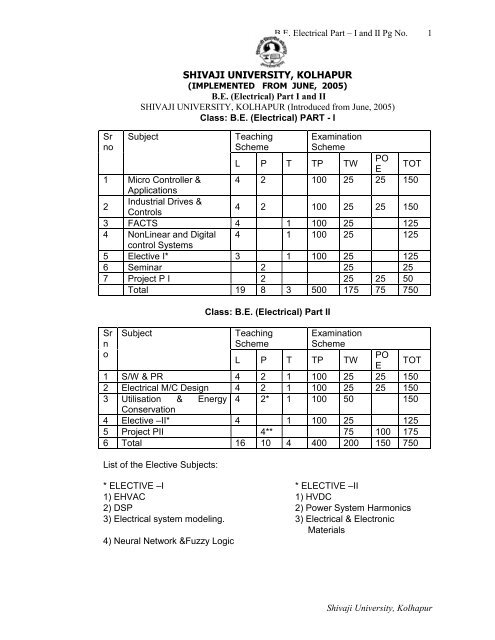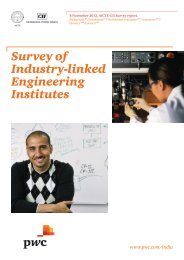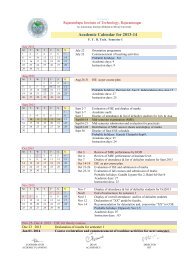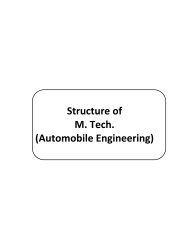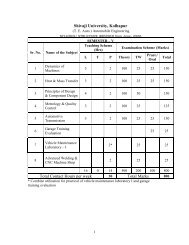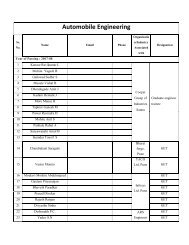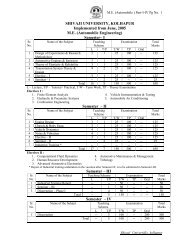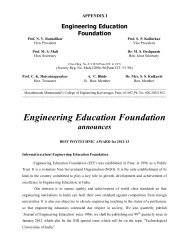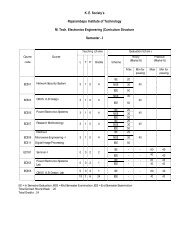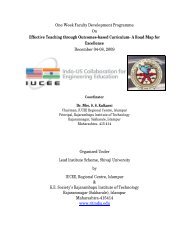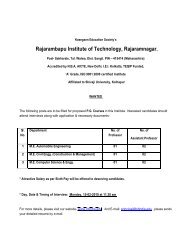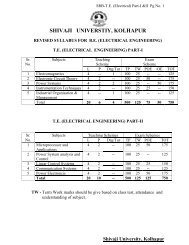SHIVAJI UNIVERSITY, KOLHAPUR
SHIVAJI UNIVERSITY, KOLHAPUR
SHIVAJI UNIVERSITY, KOLHAPUR
Create successful ePaper yourself
Turn your PDF publications into a flip-book with our unique Google optimized e-Paper software.
B.E. Electrical Part – I and II Pg No.<br />
1<br />
Sr<br />
no<br />
<strong>SHIVAJI</strong> <strong>UNIVERSITY</strong>, <strong>KOLHAPUR</strong><br />
(IMPLEMENTED FROM JUNE, 2005)<br />
B.E. (Electrical) Part I and II<br />
<strong>SHIVAJI</strong> <strong>UNIVERSITY</strong>, <strong>KOLHAPUR</strong> (Introduced from June, 2005)<br />
Class: B.E. (Electrical) PART - I<br />
Subject<br />
Teaching<br />
Scheme<br />
Examination<br />
Scheme<br />
L P T TP TW<br />
PO<br />
E<br />
TOT<br />
1 Micro Controller & 4 2 100 25 25 150<br />
Applications<br />
2<br />
Industrial Drives &<br />
Controls<br />
4 2 100 25 25 150<br />
3 FACTS 4 1 100 25 125<br />
4 NonLinear and Digital 4 1 100 25 125<br />
control Systems<br />
5 Elective I* 3 1 100 25 125<br />
6 Seminar 2 25 25<br />
7 Project P I 2 25 25 50<br />
Total 19 8 3 500 175 75 750<br />
Sr<br />
n<br />
o<br />
Subject<br />
Class: B.E. (Electrical) Part II<br />
Teaching<br />
Scheme<br />
Examination<br />
Scheme<br />
L P T TP TW<br />
PO<br />
E<br />
TOT<br />
1 S/W & PR 4 2 1 100 25 25 150<br />
2 Electrical M/C Design 4 2 1 100 25 25 150<br />
3 Utilisation & Energy 4 2* 1 100 50 150<br />
Conservation<br />
4 Elective –II* 4 1 100 25 125<br />
5 Project PII 4** 75 100 175<br />
6 Total 16 10 4 400 200 150 750<br />
List of the Elective Subjects:<br />
* ELECTIVE –I * ELECTIVE –II<br />
1) EHVAC 1) HVDC<br />
2) DSP 2) Power System Harmonics<br />
3) Electrical system modeling. 3) Electrical & Electronic<br />
Materials<br />
4) Neural Network &Fuzzy Logic<br />
Shivaji University, Kolhapur
B.E. Electrical Part – I and II Pg No.<br />
2<br />
The seminar should be on any standard research paper.<br />
*The students are supposed to make a model for<br />
unconventional energy sources and write extensive<br />
report on it.<br />
•**The Project II term work and project report should<br />
consists of following points:<br />
. •Literature Survey<br />
. •Project Theme<br />
. •Simulation<br />
. •Fabrication<br />
. •Test result and comparison & future scope.<br />
Shivaji University, Kolhapur
B.E. Electrical Part – I and II Pg No.<br />
3<br />
<strong>SHIVAJI</strong> <strong>UNIVERSITY</strong>, <strong>KOLHAPUR</strong><br />
(IMPLEMENTED FROM JUNE, 2005)<br />
BE ELECTRICAL PART- I<br />
1 Microcontroller and Applications<br />
Teaching Scheme<br />
Examination Scheme<br />
Lectures- 4 Hrs/week<br />
Paper 100 marks<br />
Practical -2 Hrs/week TW – 25, POE– 25<br />
1. 8051 Architecture: 8051 internal resources, pin diagram, I/O pins, ports and their<br />
internal logic circuits, counters, serial port, interrupt structure, SFRs and their<br />
addresses, watch dog timer, internal code memory, data memory, stack pointer,<br />
flags, bit addressable memory. Comparative study of 8051 families by diff<br />
manufacturers (ATMEL, DALLAS, PHILIPS, INFINION, SST)<br />
2. Assembly Language Programming: Study of Instruction set of 8051- data move,<br />
logical, arithmetic, jump and call instructions, Interrupt handling, timer programming,<br />
serial port communication, use of assembler and C-8051 cross compiler, simulator<br />
3. Microcontroller based system design: External memory and space decoding, reset<br />
and clock circuits, expanding I/O, memory mapped I/O, memory addresses<br />
decoding, system testing and troubleshooting.<br />
4. Real World Interfacing I: Interfacing various parallel devices to 8051 like 8255 PPI,<br />
Timer counter 8253, character LCD, 12 bit ADC such as AD574, DAC interfacing<br />
such as DAC0808, matrix keyboards, seven segment LED modules<br />
5. Real World Interfacing II: Interfacing of various serial peripherals– 8051 data<br />
communication in 8 bit UART mode, multiprocessor mode, study of SPI , I2C<br />
communication protocols.<br />
6. Microcontroller Applications (Block Schematic and flowchart): Microcontroller based<br />
automatic pf control relay, solid state energy meter using ASIC, weighing balance,<br />
serial E2PROM interfacing, temperature indicator and controller. Real time clock<br />
using DS1307<br />
Minimum 10 practicals based on above syllabus should be performed. 5 practical<br />
should be based on assembly language programming( h/w and simulator) and 5<br />
practical should be based on real world interfacing<br />
Recommended Books:<br />
1. Kenneth Ayala, The 8051 Microcontroller Architecture, Programming &<br />
Applications, 2 nd Ed., Penram International<br />
2. Muhammad Ali Mazidi, The 8051 Microcontroller and embedded systems,<br />
Pearson Education<br />
3. Device datasheet- ATMEL, DALLAS, SST etc.<br />
B.E. ELECTRICAL PART - I<br />
2. INDUSTRIAL DRIVES AND CONTROL<br />
Shivaji University, Kolhapur
B.E. Electrical Part – I and II Pg No.<br />
4<br />
Lectures : 4 Hours/Week<br />
Practical: 2 hours/week<br />
Papers =100 marks<br />
TW= 25 Marks<br />
POE=25 Marks<br />
1) INTRODUCTION TO ELECTICAL DRIVES :<br />
Types of the electrical drives, parts of the electrical drives , criteria for selections<br />
choice of electrical drives, selection of motor rating determinations for various<br />
types of duty ratio . Selection of converter rating.<br />
2) DYNAMICS OF ELECTRICAL DRIVES :<br />
Fundamental torque equation , speed torque,connection and multiquadrant<br />
operation classification of load torques.stead state stability of drives<br />
3) CONTROL OF ELECTRICAL DRIVES:<br />
Modes of the operation, speed control and drive classification, close loop control<br />
of drives.<br />
4) D.C. MOTOR DRIVES :<br />
Method of the D.C. motor control ,starting braking and speed control , single<br />
phase and three phase full controlled and half controlled converter fed D.C.<br />
drives .Multiquadrant operation of separately excited D.C. shunt motor , Dual<br />
converter fed D.C. drives, converter control of D.C. series motor, chopper<br />
controlled d.c. shunt motor drives.single quadrant and multiquadrant<br />
operation of D.C. shunt motor an chopper ,chopper control of series motor<br />
,performance and stability of variable speed D.C. drives ,Regenerative braking<br />
the D.C. series. motor.<br />
5) INDUCTION MOTOR DRIVES.<br />
Braking and speed control method for 3 phase power for stator voltage<br />
control. (A.C. regulator )VSI fed indirection motor drive .Power circuit circuit<br />
circle loop control block diagram , cycloconverter control of induction motor ,<br />
power circuit and close loop control loop of CSI and fed induction motor<br />
drives ,comparasion of fed induction motor and drive . Analysis of the inverter<br />
fed induction using Harmonics equivalent circuit, Harmoinics torque and<br />
losses with inverter fed Induction motor drives.<br />
6) SLIP RING INDUCTION MOTOR DRIVE :<br />
Chopper controlled resistance in rotor circuit , slip power recovery using<br />
cascade converter, in rotor circuit. Kramer speed control static scheribus drive.<br />
7) SUNCHRONOUS MOTOR AND BRUSHLESS D.C. MOTOR DRIVES.<br />
vsi fed sysncronous motor drives , Varialbe frequency control of multiple<br />
synchronous motor drives ,Brush less D.C. Motor drives.<br />
8) Special drives :<br />
Stepper motor drives switched reluctance motor drive Torque equation<br />
,converter circuit and motor of operation solar and battery powered drives.<br />
Shivaji University, Kolhapur
B.E. Electrical Part – I and II Pg No.<br />
5<br />
Texts and references :<br />
1) Fundamentals of the electrical drives Gopal K Dubey Narosa publication<br />
2) Power Electronics converter application By N. Mohan T.M. udeland &<br />
W.P.Robbins,jhon Wiley & sons<br />
3) Electrical Drives _ Concept and application Vedam Suryavanshi<br />
4)Advanced power Electronics & A.C. Drives B.K. Bose<br />
5) Analysis of thyristor power conditioned motors S.K.Pillar<br />
B.E. (ELCTRICAL ) PART-I<br />
3. FACTS<br />
Lectures: 3 hrs / week<br />
Tutorial: 1 hr / week<br />
TW: 25 Marks<br />
Theory 100 Marks<br />
Shivaji University, Kolhapur
B.E. Electrical Part – I and II Pg No.<br />
6<br />
1) Introduction to FACTS :<br />
Introduction of the facts devices and its importances in tranmission Network.Introduction<br />
to basic types of facts controller ,comparision of HVDC and facts.<br />
2) STATIC SHUNT COMPENSATOR : SVC AND STATCOM objectives of the<br />
shunt compensation ,method of controller Vav generator , transfer ,function dunamics<br />
performance of SVC and statcom , VAR reserve control ,comparasion between<br />
STATCOM AND svc STATIC VAR system<br />
3) STATIC SERIES COMPENSATOR : GCSC ,TSSC , TCSC AND SSSC<br />
ojectives of the series compensation ,saries capacitive compensation , power<br />
oscillation damping , variable Impedance type series copmesation switching converter<br />
type series compensators charactestics of series compensator.<br />
4)STATIC VOLTAGE AND PHASE ANGLE REGULATION TCVR and TCPAR :<br />
objective of voltage and phase angle regulators opproacties to Thyristor - controlled<br />
voltage and phase angle regulator ; switching converter based voltage and phase angle<br />
regulators.<br />
5) Comined compensator : UPFC and IPFC UPFC - Basic principle and reactive<br />
power power control control structure basic control system for P & Q control ,<br />
comrision of UPFC to series compensator and phase angle regulations.<br />
IPFC - Basic operating principle characteristics , Control structure and applications .<br />
Text/ references :-- 1) Understanding FACTS - Concept and Technology of flexible<br />
AC Transmission systems. By N.G. Hingorani & L. Gywgyi<br />
Staandered publishers Distributors.<br />
2) Static Reactive power compensation By T.J.E. Miller<br />
Jhon wiley & sons<br />
New york<br />
BE ELECTRICAL PART-I<br />
4. NON- LINEAR AND DIGITAL CONTROL SYSTEM.<br />
Lectures: 4 hrs / week<br />
Tutorial: 1 hr / week<br />
TW: 25 Marks<br />
THEORY : 100 Marks<br />
Shivaji University, Kolhapur
B.E. Electrical Part – I and II Pg No.<br />
7<br />
1. Non linear control system properties of the non linear system, common physical Non<br />
linearites. Classification of the non linearities: – single valued and multi-valued and<br />
explicit implicit non linearities , static and dynamic non linearities<br />
2. Analysis of Non linear control system:- Linearization, phase plane method , singular<br />
points, construction of phase trajectories using method of isoclines, delta and lineards<br />
construction ,Limit cycle phase plane construction using MATLAB . Describing function<br />
method, use of describing function, stability by Lyapunov’s direct method, the concept of<br />
definiteness, lyapunov stability theorem.<br />
3. Digital control system – Introduction the Z transform ,properties of Z transform, the<br />
inverse Z transform , Z transform method for solving difference equation . Impulse<br />
sampling and Data hold, Pulse transfer function, sampling theorem, Z transform &<br />
Inverse Z transform using MATLAB.<br />
4) Design of digital control system By conventional methods: - mapping between S plane<br />
and the Z plane, stability analysis of the close loop system in Z plane, transient and<br />
steady state analysis . Design based in the Root locus method, design based on the<br />
frequency response method.<br />
5) State space analysis of digital control system: - State space representation of digital<br />
control system . Solving Digital control State space equations pulse transfer function<br />
matrix.<br />
6) Pole placement and observer design:- controllability, observability, ,useful<br />
transformation in state –space Analysis and Design , Design Via pole placement, state<br />
observers.<br />
TEXT BOOKS :--<br />
1) Nagrath Gopal Control system Engg Wiley Publication .<br />
2) K.Ogata Discrete time control system Second Edition Pearson edition.<br />
Reference Book : ---<br />
1) Norman nise control system Engg 4 th edition Jhonwiley & sons<br />
2) Philips and Harbor feed back system PHI<br />
3) D.P. Atherton nonlinear control Engg<br />
4) Gelb and Vander velde Multiple input describing function<br />
and non linear system design Mc-Graw Hill<br />
5) Hsu and Meyer Modern control principles and Application<br />
Mc graw Hill.<br />
Lectures: 3 hrs / week<br />
Tutorial: 1 hr / week<br />
B.E. PART - I<br />
ELECTIVE - I<br />
i) E.H.V. A.C.<br />
TW: 25 Marks<br />
THOERY :100 Marks<br />
Shivaji University, Kolhapur
B.E. Electrical Part – I and II Pg No.<br />
8<br />
1) (A)Introduction : Engineering aspect and growth of EHV_ AC<br />
Transmission line trends and preliminaries, power transferability, transist<br />
stability,transit stability limit, and surge impedance loading.<br />
(B) Calculation of line and ground parameters:--<br />
Resistance ,power loss,temperature rise properties of bundled conductors,<br />
inductance and capacitance ,calculation of sequence inductions and<br />
capacitance line parameters for modes of propagations, resistance and<br />
inductance of the ground return.<br />
©Voltage gradients of conductor:<br />
Charge potential relations<br />
for multiconductor lines , surface voltage<br />
gradients on the conductor line , surface volage gradients on<br />
conductors,distribution of voltage gradients on subconductors of bundle.<br />
(D) I*I * R and corona loss corona loss formula charge voltage diagram<br />
with corona ,attenuation of traveling waves due to corona loss Audoable<br />
noise, cprona pulses, Their generation and properties,limit for radio<br />
interface fields.<br />
Theory of the Travelling waves and standing :<br />
The waves at the power frequency , differenential equations and solutions<br />
for generals case , standing waves and natural frequencies open ended line<br />
double exponential response , respone to sinusoidal<br />
Exitation , line energization with trapped charge voltage, Refection and<br />
refraction of traveling waves.<br />
(3) Lighting and lighting protection :<br />
Lighting strokes to lines , their mechanism, General principal of the lighting<br />
protections problems lowe footing , resistamce ,lighting arrestor and<br />
protection characteristics different arrestors and theis characteristics .<br />
(4) Over voltage in EHV sustem covered By swithing<br />
operations:--Over –voltage their types ,recovery voltage and circuits<br />
breaks , ferroresonance over voltage and calculations of switching surges<br />
single phase equivalents.<br />
(5) Power frequency voltage control and over voltage.<br />
Generalised constants, changing , current ,power circle diagram, and its<br />
use , Voltage voltage control shunt and series components, Subsyschtonous<br />
resonance in series capacitor compensated lines and static reactive<br />
compensating systems.<br />
(6) Insulation Co ordinations :--<br />
Insulation level , Voltage withstand levels of protected equipments and<br />
insulation condition based on the lighting.<br />
7. Design of EHV - AC lines.<br />
Shivaji University, Kolhapur
B.E. Electrical Part – I and II Pg No.<br />
9<br />
References :--<br />
1. EHV AC transmission Engg. By R.D. Begamudre<br />
2. EHV –AC & HVDC Transmission Engineering &Practic By<br />
S.V. Rao<br />
3. EHV -AC & HVDC transmission system enginreering<br />
Analysis and design By John Wiley & sons.<br />
BE ELECTRICAL PART –I<br />
ELECTIVE – I<br />
ii) DIGITAL SIGNAL PROCESSING<br />
Teaching Scheme:<br />
Lecture1 : 3 Periods/week<br />
Examination Scheme;<br />
Theory Paper : 100 Marks<br />
Shivaji University, Kolhapur
B.E. Electrical Part – I and II Pg No.<br />
10<br />
Tutorial: 1 period/week Term Work : 25 Harks<br />
SECTION - I<br />
1. Digital Signals and Systems : (6 Hrs.)<br />
DSP system concept. Properties of DSP system, Interconnectipn of DSP<br />
systems. Case study : Realization of an Analog Second-order Differentiator.<br />
2. Z-Transforms : ' (6 Hrs.)<br />
Z-Transform and its properties. Inverse Z-Transform, Digital transfer Function -<br />
Stability considerations and Frequency Response. Bilinear Z-Transform, Case<br />
study : Notch filter Design.<br />
3. The Discrete Fourier Transform and Fast Fourier Transform : (14Hrs.)<br />
DFT, Relation between DFT & Z-transform, Properties of DFT, Circular<br />
convolution, windows & DFT.<br />
FFT Algorithms, (DIT, FFT & DIP, FFT) Implementation Aspects. Fast<br />
convolution Signal segmentation (overlap save algorithm overlap-add algorithm).<br />
Correlation - Circular correlation, DFT property of circular correlation. Spectrum<br />
Analysis. Case study : electrocardiogram Data Compression.<br />
SECTION- II<br />
4. Realization of Digital Linear System : (2 Hrs.)<br />
Filter categories, IIR direct form structures, cascade, parallel realization, FIR<br />
filter realization.<br />
5. FIR Filter Design : (6 Hrs.)<br />
Characteristics of FIR Filter. Properties of FIR Filter. Digital Network for FIR<br />
Filter. Windowing method. Filter design using Kaiser Window.<br />
6. IIR Filter Design : (7Hrs.)<br />
Impulse Invariant Technique, Bilinear transformation. Frequency band<br />
transformation, Analog Filter Approximation. (Butterworth, Chebyshev, Elliptic).<br />
(sin x)/x Digital Correction Filter.<br />
Quantization and Rounding Problems - quantization of the signal, effects of<br />
Finite Word Length on stability and frequency response, arithmetic errors.<br />
Case study : Digital Filters for FSK Modem.<br />
7. Practical Implementation Considerations : (7 Hrs.)<br />
Introduction, implementation using Microprocessors. Case study :<br />
Microprocessor-based Digital Filter.<br />
Shivaji University, Kolhapur
B.E. Electrical Part – I and II Pg No.<br />
11<br />
DSP Chips - TMS32026 Digital Signal Processor. Case study : TMS320C26-<br />
based Digital Filter. (Block Diagram Approach).<br />
Architecture, Features of Digital Signal Processors of Analog Devices.<br />
References :- .<br />
1. Digital Signal Processing : A Student Guide, T. 3. Terrel and Lik-Kwan Shark.<br />
2. Digital Signal Processing - Principles, Algorithms and Applications., 3ohn G,<br />
Proakis.<br />
3. Discrete Tme Signal Processing - A. V. Oppenheim and R. W. Schafer (PHI)<br />
4. Digital Signal Processing - A System Design Approcah., D. 3. Defatta.<br />
5. Introduction to Digital Signal Processing - Johnny R. Johnson.<br />
6. Signals and Systems - D. D. Shah and A. C. Bhagali.<br />
B.E. ELECTRICAL PART- I<br />
ELECTIVE-I<br />
iii) Electrical System Modeling<br />
Teaching Scheme:<br />
Examination Scheme;<br />
Lecture1 : 4 Periods/week<br />
Theory Paper : 100 Marks<br />
Tutorial: 1 period/week Term Work : 25 Harks<br />
1. Basic concepts of dynamical systems, formation of state space equations.<br />
Shivaji University, Kolhapur
B.E. Electrical Part – I and II Pg No.<br />
12<br />
Concept of dynamic instability '<br />
a) Voltage instability<br />
b) Angle instability ..<br />
c) steady state and dynamic problems in A.C. systems<br />
2. Modeling of power system components<br />
a) Synchronous machine, .Excitation system, Prime movers Governors<br />
b) Transmission. lines. Transformers and loads<br />
c) FACTS devices<br />
3. Analysis of single machine and multi machine system<br />
4. Small signal angle instability<br />
Damping and synchronizing torque analysis, Eigen value analysis,<br />
Mitigation using Power System Stabilizers (PSS) and supplimentory<br />
modulation and control of FACTS devices.<br />
5. Sub synchronous oscillation<br />
Analysis and counter measures • using PSS and FACTS devices.,<br />
6. Transient instability :-<br />
a) Analysis using digital simulation<br />
b) Analysis using energy function<br />
c) Study of various numerical methods<br />
1. Fixed step methods<br />
2. variable step methods<br />
7. Analysis of voltage instability and counter measures<br />
References:-<br />
1. Power System Voltage Stability ; C.W. Taylor<br />
2. Power System Stability & Control ; Anderson P.M. and Fauad<br />
3. Power System Stability & Control ; P. Kundur<br />
4. Power System Dynamics & Stability ; K.R. Padiyar<br />
5. Computer-Analysis of Power Systems ; Arrillaga & Arnold<br />
6. Electric Energy Systems ; Olle Elegard<br />
7. Understanding FACTS ; N.G.Hingorani & L.Gyugyi<br />
8. Power System Operation and Control ; P.S.R. Murthy<br />
9. Energy Function Analysis for ; M.A.Pai<br />
Power System Stability<br />
iv)<br />
B. E. ELECTRICAL PART-I<br />
ELECTIVE - I<br />
NEURAL NETWORK & FUZZY LOGIC<br />
Teaching Scheme:<br />
Examination Scheme;<br />
Lecture: 3 Hours/week<br />
Theory Paper : 100 Marks<br />
Tutorial: 1 Hour/week Term Work : 25 Marks<br />
1. Introduction to Neural Network: History, Applications, Biological Inspiration.<br />
Shivaji University, Kolhapur
B.E. Electrical Part – I and II Pg No.<br />
13<br />
2. Neuron Model and Network Architecture:- Neuron Model, Transfer function,<br />
Network Architecture, Recurrent Networks, Perceptron, Hamming Network,<br />
Feedforward layer, Hopfield Network.<br />
3. Perceptron Learning Rules:- Learning Rules, Perceptron Architecture,<br />
Perceptron learning rule, constructing learning rules.<br />
4. Signal and Weight Vector Spaces:- Linear vector spaces, inner product,<br />
norm, orthogonality, Gram Schmidth orthogonalization, linear transformations<br />
for neural networks.<br />
5. Performance Surfaces and Optimum points:- Taylor series, directional<br />
derivatives, minima, necessary conditions for optimality, performance<br />
optimization, steepest descent, Newton’s Method, Conjugate gradient.<br />
6. Widrow- Hoff Learning rule:- Adaline network, mean square error, LMS<br />
algorithm.<br />
7. Back propagation:- Multilayer Perceptrons, the Back propagation Algorithm,<br />
Variation of backpropagation, Heuristic modifications of back propagation,<br />
momentum, Levenberg-Marquardt Algorithm.<br />
8. Stability and Hopfield Network:- Recurrent Networks, Lyapunov stability<br />
theorem, Hopfield Model, Lyapunov function, Hopfield Design.<br />
9. Introduction to Fuzzy Logic:- Mathematics of Fuzzy control, Fuzzy set theory,<br />
Fuzzy relations, approximate reasoning, fuzzy if then statements, inference<br />
rules.<br />
10. Representing a set of rules:- Mamdani versus Gödel, Properties of set of<br />
rules, continuity of a set of rules, interaction of a set of rules.<br />
11. FKBC Design parameters:- The structure of FKBC, rule base, data base,<br />
inference engine, Choice of Fuzzification and Defuzzificatin procedures, PID<br />
like FKBC,Sugeno FKBC.<br />
Note: - Term work should be based on MATLAB exercises.<br />
TEXT BOOKS:-<br />
1. Neural Network Design by Hagan, Demuth, Beale, First edition, PWS<br />
publishing company 1996.<br />
2. An Introduction to Fuzzy Control by Driankov, Hellendoorn, Reinfrank,<br />
First edition Narosa publishing 1993<br />
Lectures: 4 hrs / week<br />
Practical: 2 hrs / week<br />
Tutorial: 1 hr / week<br />
<strong>SHIVAJI</strong> <strong>UNIVERSITY</strong>, <strong>KOLHAPUR</strong><br />
(Implemented from June, 2005)<br />
B.E. (ELECTRICAL) Part II.<br />
1. Switchgear and Protection<br />
Syllabus<br />
TW: 25 Marks<br />
POE: 25 Marks<br />
Shivaji University, Kolhapur
B.E. Electrical Part – I and II Pg No.<br />
14<br />
Circuit Breakers<br />
1 – Voltage - current characteristics of arc, Principles of DC and AC arc<br />
interruption, high resistance and current zero interruption, arc voltage, Transient<br />
Restriking Voltage (TRV), Recovery voltage, RRRV, current chopping, resistance<br />
switching, capacitive current interruption.<br />
8 hrs<br />
2 - Classification of circuit breakers, brief study of construction and working of bulk<br />
oil and minimum oil CB, Air break and Air Blast CB, SF6 and Vacuum CB,<br />
HVDC breakers, ratings of CB and testing of CB<br />
8 hrs<br />
3 - Fuse – Rewirable and HRC fuse, fuse characteristics, application and selection of<br />
fuse.<br />
2 hrs<br />
Relays<br />
4 - Selectivity, sensitivity, reliability and speed of operation of a relay, CT burden<br />
calculation, attracted armature, balanced beam, moving coil relays, theory and<br />
construction of induction disc and induction cup relays.<br />
3 hrs<br />
5 - Over current Protection – Plug setting, time setting, radial feeder and ring mains<br />
protection, earth fault and phase fault, numericals on relay settings, Directional<br />
relay, and microprocessor based o/c relay.<br />
4 hrs<br />
6 - Differential Relays – circulating current and opposed voltage principles,<br />
percentage differential relay, line protection, carrier aided protection scheme.3 hrs<br />
7 - Transformer protection – Problems associated with percentage differential<br />
protection, harmonic restraint and harmonic blocking schemes, restricted earth<br />
fault protection, Buchholz relay for incipient faults.<br />
3 hrs<br />
8 - Generator protection – stator earth fault, phase fault, stator current unbalance<br />
(NPS) protection, Rotor overheating, earth fault protection, excitation failure and<br />
protection against motoring, generator-transformer unit protection. 3 hrs<br />
9 - Distance protection – Impedance, reactance and admittance characteristics, relay<br />
settings for 3-zone protection, out of step blocking scheme, blinder relay,<br />
numerical relays for transmission line protection, microprocessor based<br />
impedance, reactance and mho relays.<br />
5 hrs<br />
10 - Over voltage Protection – Causes of over voltages, surge arrestors and absorbers,<br />
metal oxide (ZnO) arrestors, insulation co-ordination in a power system. 3 hrs<br />
Tutorial:<br />
1 Simulation of a simple power system and operation of circuit breakers.<br />
2 Calculation of relay settings for radial and ring feeders.<br />
Practicals: Minmum 6 of the following list<br />
1) Drawing sheet for MOCB, ABCB, SF6 CB and Vacuum CB.<br />
2) Drawing sheet for Generator and transformer protection schemes.<br />
Shivaji University, Kolhapur
B.E. Electrical Part – I and II Pg No.<br />
15<br />
3) Study of construction and working of induction disc type relays.<br />
4) Plotting of I – t characteristics of an IDMT over current or E/F relay.<br />
5) Experimental study of working of a Directional O/C relay .<br />
6) Experimental realization of microprocessor based O/C relay.<br />
7) Experimental realization of microprocessor based impedance relay.<br />
8) Experimental realization of microprocessor based Directional O/C relay.<br />
References:<br />
1) Power System Protection and Switchgear – B.Ram & B.N. Vishwakarma<br />
2) Switchgear and Protection - S.S. Rao<br />
3) Digital Protection – L.P.Singh<br />
4) Switchgear and Protection – M.V. Deshpande<br />
B. E. (ELECTRICAL) PART - II<br />
2. ELECTRICAL MACHINES DESIGN<br />
Teaching Scheme<br />
Examination Scheme<br />
Lectures - 4 Hrs/Week Paper - 100 Marks<br />
Practical - 2 Hrs/Week T. W. - 25 Marks<br />
Tutorial - 1 Hrs/Week P.0. E. - 25 Marks<br />
Shivaji University, Kolhapur
B.E. Electrical Part – I and II Pg No.<br />
16<br />
1. Transformers :<br />
(a) Constructional details : Core and shell types. Distribution and Power<br />
transformers, core and core materials, cooling of cores, windings. Terminals and<br />
leads, cooling of transformers. Tank, Transformer oil, conservators and<br />
breathers.<br />
(b) Design : Output equation, EMF per turn. Ratio of iron loss to copper loss,<br />
Relation between core area and weights of iron and copper, optimum designs<br />
Core design. Design of windings. Design of insulation, overall dimensions.<br />
(c) Operating Characteristics : Resistance of windings. Leakage reactance,<br />
mechanical forces. Calculation of no-load current. Equivalent circuit and<br />
performance characteristics. Temperature rise. Design of tank and radiators.<br />
2. Three Phase Induction Motors :<br />
(a) Constructional details : Stator, Stator windings, stator frame. Rotor core.<br />
Rotor windings. Slip rings, shaft and bearings.<br />
(b) Design : Output equation. Specific electric and magnetic loadings. Efficiency<br />
and power factor, main dimensions, Stator windings. Type of winding and<br />
connection Turns per phase, shape of stator slots. Number of stator slots, slot<br />
insulation, Design of stator stampings.<br />
Rotor Design : Calculation of air gap length. Design of squirrel cage rotor,<br />
Elimination, of harmonic torques. Rotor bar current. Shape and size of rotor<br />
slots. Rotor slot insulation. End ring current. Area of end rings, slip. Design of<br />
wound rotor. Number of rotor slots. Number of rotor turns. Area of rotor<br />
conductors, rotor slot insulation. Rotor windings. Rotor teeth. Rotor core, Design<br />
of rotor stampings. Use of standard stampings.<br />
(c) Operating Characteristics : No load current Magnetizing current, loss<br />
component short circuit current. Resistances, leakage reactance. Use of circle<br />
diagram to obtain performance figures. Calculation of static torque, maximum<br />
torque, maximum output, maximum power factor. Dispersion coefficient. Effect of<br />
dispersion coefficient on maximum p.f. and overload capacity.<br />
3. Single Phase Induction Motors :<br />
(a) Types and constructional details : Types of single phase induction motor<br />
construction, stator, Stator windings. Rotor, Starting switches. Electrolytic<br />
capacitor.<br />
(b) Design : Output equations, specific loadings. Main dimensions. Relative size<br />
of single phase and three phase motors, design of stator. Design of running<br />
Shivaji University, Kolhapur
B.E. Electrical Part – I and II Pg No.<br />
17<br />
winding, Number of stator slots, size of stator slot, Stator teeth, Stator core,<br />
length of mean turn, Airgap length.<br />
Design of rotor. Number of rotor slots. Area of rotor bars. Area of end ring. Rotor<br />
resistance. Rotor teeth Rotor core.<br />
(c) Operating characteristics : MMF for air gap. Saturation factor. Iron loss.<br />
Friction and windage losses. Parameters, Running winding resistance. Rotor<br />
resistance, Leakage reactance calculation. Running performance. Equivalent<br />
circuit, Veinott’s method, Pullout torque.<br />
(d) Design of Auxiliary winding : Auxiliary winding for capacitor start/run motors,<br />
Number of turns. Distribution of turns. Length of mean turn. Starting torque.<br />
4. Design of Synchronous Machines : Review of construction of water wheel and<br />
turbo alternators. Different parts and materials used for different parts, choice of<br />
electric and magnetic loadings, Output equation Determination of diameter and<br />
length. Length of air gap and effect of short circuit ratio on machine performance.<br />
Term Work : The term work consists of the design reports along with the drawing<br />
sheets of assembly of machines and the details there of in case of<br />
(i) Transformer, (ii) 1-Phase or 3-phase Induction Motor.<br />
Books Recommended<br />
1. A Course in Electrical Machine Design - by A. K. Sawhney, Dhanpat Rai and<br />
Sons, Delhi.<br />
2. Design of Electrical Machines (DC S AC) by V. N. Mittle., Standard Publishers<br />
Distributors, Delhi.<br />
3. Performance and design of AC Machines by M. fir. Say.<br />
4. Design and Testing of Electrical Machines (Second Edn.) by, M. V.<br />
Deshpande, A. H. Wheeler and Co. Allahabad.<br />
5. Computer Aided Design of Electric Machinery by C. G. Veinott, The MIT<br />
Press.<br />
B.E. (ELECTRICAL) Part II<br />
3. Utilization and Energy Conservation<br />
Syllabus<br />
Lectures: 4 hrs / week<br />
TW: 25 Marks<br />
Practical: 2 hrs / week<br />
POE: 25 Marks<br />
Tutorial: 1hr / week<br />
Shivaji University, Kolhapur
B.E. Electrical Part – I and II Pg No.<br />
18<br />
Electric Traction<br />
3 Electric traction – DC, AC and composite traction systems, main line and suburban<br />
systems, Comparison with Diesel-Electric traction.<br />
2 hrs<br />
4 Train movement and Energy consumption – Trapezoidal and quadrilateral<br />
speed-time curves, Maximum, average and scheduled speeds, Mechanics of train<br />
movement, tractive effort calculation, Power and energy output from driving<br />
axles, Specific Energy Output numericals.<br />
6 hrs<br />
5 Traction motors and their Control – D.C. series, A.C. series and 3 Ph Induction<br />
motors for traction, Brief introduction to rheostatic speed control methods, drum<br />
controller, Multiple Unit Control, modern methods of speed control using SCR,<br />
GTO and IGBT. Use of microprocessors for control of traction motors. 6 hrs<br />
6 Braking of traction motors – Vacuum brake and Air brake systems, regenerative<br />
braking, calculation of energy returned during regenerative braking, 2 hrs<br />
7 Trolley wire, catenaries, Feeding and distribution systems, negative booster. 3 hrs<br />
Utilization<br />
6 Electric Drives – Choice of drive, size and rating of motors for the drive, Classes of<br />
insulation, Heating and cooling curves, derivation of heating and cooling time<br />
constants, numericals, Load equalization, flywheel calculations, capitalization of<br />
losses and selection of most economical motor.<br />
7 hrs<br />
7 Electric Heating and welding – Classification of electric heating methods,<br />
Resistance heating, design of heating element, Arc furnaces, Coreless Induction<br />
furnace, Dielectric heating, numericals on dielectric heating. Electric arc welding,<br />
Power supply & control of electric welding, Laser beam welding.<br />
6 hrs<br />
Conservation of Electrical Energy<br />
8 Energy Crisis – Causes and effects of energy crisis, Need for energy conservation,<br />
global and Indian scenario.<br />
1 hr<br />
9 Energy Management & Audit: Definition, Energy audit- need, Types of energy<br />
audit, Energy management (audit) approach-understanding energy costs, Bench<br />
marking, Energy performance, Matching energy use to requirement, Maximizing<br />
system efficiencies, Optimizing the input energy requirements, Fuel and energy<br />
substitution, Energy audit instruments.<br />
9 hrs<br />
_______________________________________________________________________<br />
Practical:<br />
1) Visit to a local industry for the study of electrical energy utilization. A<br />
comprehensive report to be submitted.<br />
2) Prepare the energy audit report for the industry visited.<br />
3) Prepare a model of renewable energy source and submit a report on the same.<br />
References:<br />
1) Utilization of Electric Power & Electric Traction (VIII edition) – J.B. Gupta<br />
Shivaji University, Kolhapur
B.E. Electrical Part – I and II Pg No.<br />
19<br />
2) Art and science of utilization of Electric Energy – H. Partab<br />
3) A course in Electrical Power – Soni, Gupta & Bhatnagar<br />
4) Bureau of Energy Efficiency, Energy manager training – ebook1, chapter 3<br />
B.E. ELECTRICAL PART- II<br />
ELECTIVE –II<br />
i) H. V. D.C. Engineering<br />
Teaching Scheme<br />
Examination Scheme<br />
Lectures : 4 Hrs/Week Paper : 100 Marks.<br />
Tutorial : 1 Hr/Week TW :25 Marks.<br />
Shivaji University, Kolhapur
B.E. Electrical Part – I and II Pg No.<br />
20<br />
1. General Aspects HVDC Transmission:<br />
Constitution of EHVAC and DC links, Kinds of DC links, HVDC projects in<br />
India and abroad, limitations and advantages of HVDC transmission over<br />
EHVAC, Layout of HVDC station.<br />
2. Grid Control and Characteristics:<br />
Grid control of thyristor valve-Basic means of control, Power reversal, manual<br />
control and its limitations-constant current versus constant voltage, desired<br />
features of control, actual control characteristics-constant minimum ignition<br />
angle, current and extinction angle controls – stability of control, power control<br />
and current limits.<br />
3. Protection:<br />
Misoperation of converters-short circuit on a rectifier – commutation failure,<br />
causes and remedies – Protection of HVDC system, d.c. rectors, damper circuits,<br />
Over-current protection and over-voltage protection, clearing fault and<br />
reenergizing the line.<br />
4. Harmonics and Filters:<br />
Characteristic and uncharacteristic harmonics-causes, consequences and<br />
suppression-Troubles caused by harmonics, Definitions used in Harmonic<br />
distortion calculations, Harmonic filters : Types, Location criteria for adequacy,<br />
5. Reactive Power Compensation:<br />
Concept of reactive power compensation- reactive Power balance in HVDC<br />
substations-Effect of angle of advance and extinction angle on reactive power<br />
requirement of converters.<br />
6. Multi-terminal DC Systems<br />
Introduction, Potential Applications of MTDC Systems, Types of MTDC<br />
Systems, Control and Protection of MTDC Systems<br />
TERM WORK:<br />
Term work will consist of at least Five assignments related to the problems in<br />
HVDC Transmission.<br />
BOOK RECOMMENDED:<br />
1. Direct Current Transmission, -by E.W. Kimbark. Vol. – I John Wiley,<br />
New York Edn. 1971,<br />
2. HVDC Power Transmission System, By K.R. Padiyar , Wiley Eastern Ltd.<br />
New Delhi.<br />
3. Power Transmission by Direct Current –by E. Usdimann Springer Ver<br />
4. lag, Berlin Edn. 1975.<br />
5. EHVAC and HVDC Transmission, - by S.S. Rao Khanna Pub. Delhi.<br />
===000===<br />
B.E.- (Electrical) Part-II<br />
Elective -II<br />
ii) Power Systems Hormonics<br />
Teaching Scheme:<br />
Examination Scheme;<br />
Lecture1 :3 Periods/week<br />
Theory Paper : 100 Marks<br />
Tutorial: 1 period/week Term Work : 25 Harks<br />
Shivaji University, Kolhapur
B.E. Electrical Part – I and II Pg No.<br />
21<br />
Part-I :- Introduction<br />
1. Introduction to Power, quality<br />
2. Power quality characteristic<br />
3. Power duality standards:<br />
Part-II Power quality Issues and their solutions<br />
4. Protection against voltage sags and interuptions<br />
5. Wiring and grounding problems and their solution<br />
6. transient over voltages due to lighting and switching<br />
7. Power system harmonics and filtering<br />
8. Technical impact of problems on various load equipments<br />
9. Utility and end user strategies for improving power quality<br />
Part-Ill Power quality assessment and Economics<br />
10 Power quality measurement tools<br />
11 Power quality assessment.<br />
12 Power quality Economics<br />
13 Future trends<br />
References:<br />
1.Electrical Power Systems quality Roger C. Dugan, McGran aghan, H Wyne,<br />
MeGraw Hill Professional Publishing 1995<br />
2. Power Systems. Hormonics by j. Arrillaga<br />
BE ELECTRICAL PART-II<br />
ELECTIVE -II<br />
iii) Electrical and Electronic Materials<br />
Teaching Scheme<br />
Examination Scheme<br />
Lectures : 4 Hrs/Week Paper : 100 Marks.<br />
Tutorial : 1 Hr/Week TW :25 Marks.<br />
Shivaji University, Kolhapur
B.E. Electrical Part – I and II Pg No.<br />
22<br />
1. Introduction to Electrical and Electronic Materials: Engineering materials,<br />
Classification, properties, Energy bond description<br />
2. Conductive materials:<br />
Ohm’s law and relaxation time of electrons: relaxation time, collision time and<br />
mean free path<br />
Electric scattering and resistively of metals<br />
Heat developed in current carrying conductor<br />
Thermal conductivity of metals, Superconductivity, cryoconductors.<br />
3. Dielectric materials<br />
A) Dielectric properties in static field: polarization and its mechanism,<br />
dielectric constant of monoatomic gases,<br />
a) dielectric breakdown in liquid - colloidal theory, Bubble theory,<br />
Breakdown due to liquid globules<br />
b) dielectric breakdown of solid: Intrinsic breakdown, Frochlich’s theory,<br />
Theory of Van Hippel, Thermal and discharge breakdown<br />
c) dielectric breakdown in gases : Growth of current, breakdown mechanism,<br />
electron ionization coefficient, secondary ionization coefficient,<br />
Townscnd’s criterion<br />
B) Dielectric properties in alternating field: Frequency dependence of electronic<br />
polarisiblity, ionic polarization as function of frequency, complex dielectric<br />
constant of non dipolar solids, dielectric losses.<br />
4. Insulating materials: Dielectric gases, liquid insulating materials, solid insulating<br />
materials, modern trends in electrical insulators, insulation measurement, electric<br />
strength of liquids, factor influencing the characteristics of insulating system.<br />
Effect of moisture on insulating system. Insulating materials for electric and<br />
electronic equipments.<br />
5. Magnetic properties of materials: Magnetic material classification, origin of<br />
permanent magnetic dipole, Dimagnetism, Paramagnetism, ferromagnetic<br />
domains, Magnetostriction, factor affecting permeability and hysteresis loss, anti<br />
ferromagnetism, ferrimanetism, magnetic resonance<br />
References:<br />
1) Electronic Engineering Materials and devices : J.Allison , Mc-Grawhill Pub.<br />
2) Electric and radio engineering materials: B. M. Tareev , Mir Publication<br />
3) Electric engineering Materials: A. J. Dekker , Prentis Hall Publication<br />
K:\eback\newsyllabus\engineering\B.E\B.E. (Electrical )\sysllabus be part i & ii electrical engg..doc/ birje<br />
SURESH P. SAWANT<br />
BIRJE SR/ JC<br />
Shivaji University, Kolhapur


